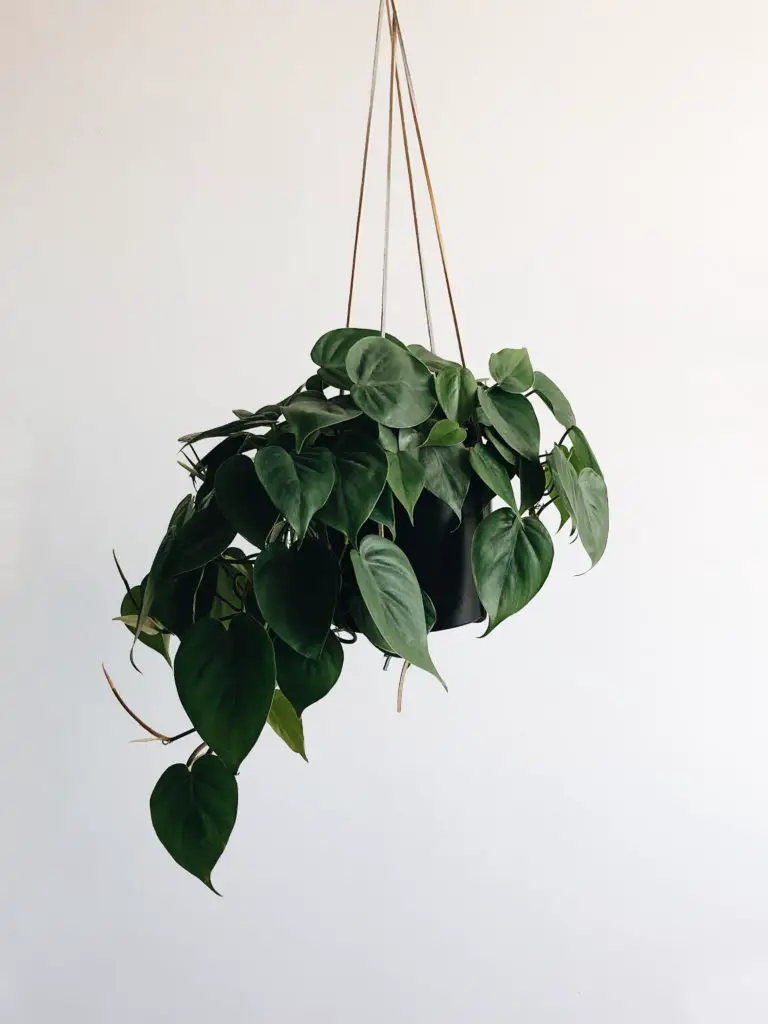Please note that this post may contain affiliate links. You can read my full affiliate disclosure at the bottom of the page.
The Heartleaf Philodendron is one of the most common houseplants you see in stores. They are very easy to care for and can adapt to many different environmental conditions. The leaves are the shape of a heart, have a deep green color, and grow in a trailing vine. Many Philodendron fans start out with this type of Philodendron plant and fall in love with them. In this Heartleaf Philodendron plant care guide, we go over how to care for your Heartleaf Philodendron and give you tips on how you can help your plant thrive.
- Origins
- Heartleaf Philodendron Care TL;DR
- Heartleaf Philodendron Light Requirements
- Heartleaf Philodendron Water Requirements
- Heartleaf Philodendron Soil
- Pots
- Fertilizer
- Temperature
- Humidity
- Pruning
- Heartleaf Philodendron Propagation
- Is The Heartleaf Philodendron Toxic to Pets?
- Common Heartleaf Philodendron Problems
- Frequently Asked Questions About Heartleaf Philodendrons
Origins
Heartleaf Philodendron Scientific Name and Other Names
- Philodendron hederaceum
- Philodendron cordatum
- Heartshaped Philodendrons

Heartleaf Philodendron Care TL;DR
The Heartleaf Philodendron is one of the easiest Philodendrons to take care of. You do not need to stress too much over these plants as you would other Philodendrons that can be a bit more touchy to changes in the environment. This is why you often see these in offices along with Pothos plants.
- Low, medium, or indirect bright light.
- Allow the top few inches of soil to dry out between watering.
- Use a pot that allows for drainage.
- Don’t let the temperature go below 55°F.
- Can adapt to low humidity or high humidity well. Optimal humidity around 40%.
- Regular soil mix with perlite.
- Liquid houseplant fertilizer as directed on the bottle. Half dose is better.
Other Philodendron Care Guides:
- Philodendron Burle Marx Care
- Philodendron Billietiae Care Guide
- Philodendron Dark Lord
- Philodendron Imperial Red Care
- Philodendron Melanochrysum Care
- Silver Sword Philodendron Care Guide
- Birkin Philodendron Care Guide
- Philodendron Brasil Care Guide
Heartleaf Philodendron Light Requirements
This plant is one of those that are not too picky about its light. They can do well in low light, medium light, or bright indirect light. The only thing that they are most sensitive to is direct sunlight. Lower light will cause slower growth than if it was in a brightly lit area.
Heartleaf Philodendron Water Requirements
Allow the top few inches of the soil to dry before you water your plant. Do not water if the soil is still moist when you check it.
The best way to test the soil moisture is to use your finger to feel the moisture. Just stick your finger into the soil and see how it feels. If this isn’t an option for you, you can also use a moisture meter. But sometimes they are not that accurate.
Heartleaf Philodendron Soil
You can use regular potting soil with perlite for these plants. They are not too picky about what soil medium you put them in. Just make sure that the soil drains well to avoid having the plant roots sitting in stagnant soggy soil.

Pots
Make sure that the pot you put your plant in allows for drainage. Just like with the well-draining soil, you don’t want the roots sitting in soggy soil.
If you want to use a hanging pot so your plant’s vines can trail over make sure to get one that has a reservoir to avoid any water dripping out and onto things below the pot.
Fertilizer
You can use a liquid fertilizer for regular houseplants for the Heartleaf Philodendron. Just follow the directions on the bottle. I usually cut the amount that it says to give them in half to avoid any nutrient burn.
Temperature
Heartleaf Philodendrons do best with temperatures above 55°F. The ideal temperature range is between 60°F and 80°F. If it gets too hot for too long you will start to see wilting and limp leaves on the plant.
Humidity
The average humidity of around 40% is great for these plants, but they are very adaptable. They can do well in low or high humidity. This makes it a great plant if you live in an area that has some seasons with very low humidity and others with very high humidity.
The main difference will be that in low humidity the plant will need to be watered more often than when the humidity is high.
Pruning
Remove any dead and/or damaged leaves when you find them on your Philodendron.
When you want to remove a good amount of foliage from the plant do so during the spring or summer when it is the plant’s growing season.
To prune your plant make sure to use sharp sterilized plant shears or scissors. Having them sterilized can help ensure you don’t spread disease or bacteria to your plant.
Heartleaf Philodendron Propagation
Propagation is easy to do with these plants, you just need to get a stem cutting with at least one leaf on it.
To get a stem cutting you want to make sure you get a node in your cutting. This will be the part where the leaf is coming off the main vine/stem. Cut a few inches below the node. Place the cutting in water and in a bright area.
Propagation stations are my favorite way to start my plant cuttings.
Roots should start growing in a week or two after you put the cutting in water. Once the roots have grown a couple of inches you can put the cutting in soil. Keep the soil moist for the first two weeks as the cutting adapts to being in soil.
Is The Heartleaf Philodendron Toxic to Pets?
Yes, the Heartleaf Philodendron is toxic to pets. According to the ASPCA all Philodendrons can be harmful to pets because they contain calcium oxalate crystals. If your pet ingests any of your Philodendron plant call your veterinarian.
Common Heartleaf Philodendron Problems
Root Rot
Overwatering your plant can lead to root rot. When this happens the soil constantly feels moist but your plant looks limp like it needs water. Often leaves will start to turn yellow and become squishy to the touch.
Repotting the plant is the only way to try to get rid of the root rot. You will want to remove the plant from its current pot and clean out the existing soil from around the root ball. Trim off any damaged and brown and mushy-looking roots, these are the damaged roots. Put the plant into its new pot with new soil. But be aware that this does not always fix root rot. Many plants don’t recover.
Curling Leaves
This can be a sign that the plant is underwatered. Only allow the plant’s soil to dry out in the top few inches, never let the entire pot of soil completely dry out.
Browning Leaves or Tips
Leaves turning brown or the tips turning brown are another sign that the Heartleaf Philodendron is being allowed to dry out too much and go too long between waterings.
Increase the amount of water and the frequency that you are watering the plant if you start to notice this issue.
Frequently Asked Questions About Heartleaf Philodendrons
Light for these plants can be anywhere from low light to indirect bright light. The amount of light will affect the growth rate, with low light resulting in slower growth than the plant would have in bright light.
Yes, the Heartleaf Philodendron can climb. The vines will climb up things as you train the vine or you can let it hang and trail down. Many people use a moss pole in the pot when getting a Philodendron to climb.